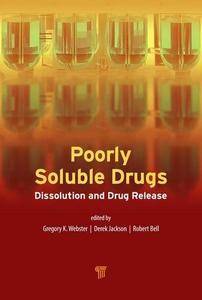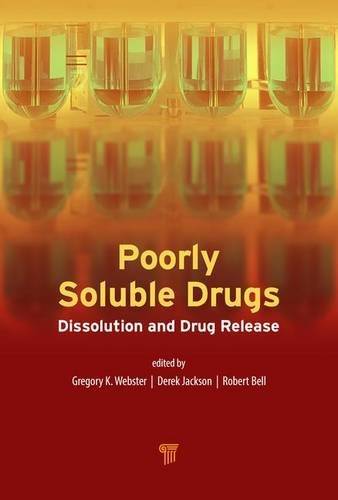Poorly Soluble Drugs: Dissolution and Drug Release
Pan Stanford | English | January 2017 | ISBN-10: 9814745456 | 728 pages | PDF | 15.05 mb
Pan Stanford | English | January 2017 | ISBN-10: 9814745456 | 728 pages | PDF | 15.05 mb
by Gregory K. Webster (Author), Robert G. Bell (Author), J. Derek Jackson (Author)
Features
Comprehensive assessment of the application of fundamental principles of dissolution and drug release testing to poorly soluble compounds (BCS Class 2 and 4) and formulations
Biorelevant phase-appropriate approaches to dissolution development
Formulation and solubilization techniques to overcome solubility challenges associated with the development of BCS Class 2 and 4 products
Dissolution instrumentation and media selection for dissolution development with various dosage forms
Summary
This book is the first text to provide a comprehensive assessment of the application of fundamental principles of dissolution and drug release testing to poorly soluble compounds and formulations. Such drug products are, vis-à-vis their physical and chemical properties, inherently incompatible with aqueous dissolution. However, dissolution methods are required for product development and selection, as well as for the fulfillment of regulatory obligations with respect to biopharmaceutical assessment and product quality understanding. The percentage of poorly soluble drugs, defined in classes 2 and 4 of the Biopharmaceutics Classification System (BCS), has significantly increased in the modern pharmaceutical development pipeline. This book provides a thorough exposition of general method development strategies for such drugs, including instrumentation and media selection, the use of compendial and non-compendial techniques in product development, and phase-appropriate approaches to dissolution development.
Emerging topics in the field of dissolution are also discussed, including biorelevant and biphasic dissolution, the use on enzymes in dissolution testing, dissolution of suspensions, and drug release of non-oral products. Of particular interest to the industrial pharmaceutical professional, a brief overview of the formulation and solubilization techniques employed in the development of BCS class 2 and 4 drugs to overcome solubility challenges is provided and is complemented by a collection of chapters that survey the approaches and considerations in developing dissolution methodologies for enabling drug delivery technologies, including nanosuspensions, lipid-based formulations, and stabilized amorphous drug formulations.
Author(s) Bio
Gregory K. Webster is a senior principal research scientist with AbbVie Inc.’s Global Analytical Research and Development. He obtained his BS in chemistry from St. Xavier College, USA, MS in analytical chemistry from Governors State University, USA, and PhD in analytical chemistry from Northern Illinois University. Dr. Webster’s industrial career spans an employment history with several major pharmaceutical companies. His first book with Pan Stanford Publishing, Supercritical Fluid Chromatography: Advances and Applications in Pharmaceutical Analysis, was published in 2014.
Robert G. Bell is president of Drug and Biotechnology Development LLC, USA, a consultancy to the pharmaceutical industry and academia for biological, drug, and device development. He received his education from the University of Florida and has worked with the pharmaceutical industry for over 30 years. Dr. Bell is adjunct faculty at Virginia Commonwealth University and the University of Florida College of Pharmacy and a member of the Council of Experts, General Chapters—Biological Analysis for United States Pharmacopeia.
J. Derek Jackson is director of Analytical Development at Flexion Therapeutics Inc, USA. He earned his BS and MA in chemistry from the College of William and Mary in Virginia. Derek has been engaged in all stages of pharmaceutical discovery, research, and development for 20 years, in both large pharma and small- to midcap biotech companies.



